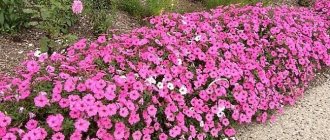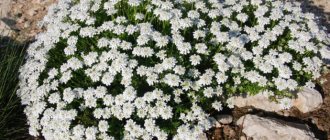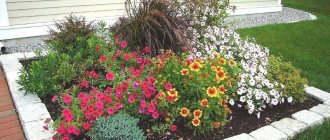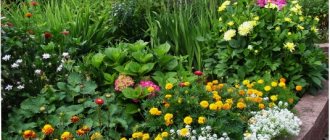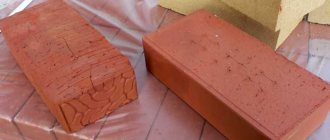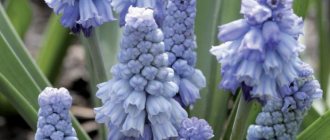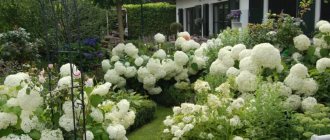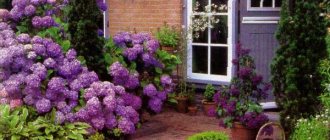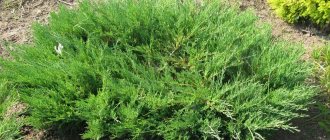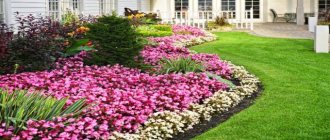Plant Features
Low-growing perennials are a universal solution for the landscape designer. With the help of crops it is easy to create a composition of any complexity, radically transforming the boring design of the site. With the onset of cold weather, the green mass dies off and the roots go into hibernation. In spring, the underground parts awaken and shoots grow.
Depending on the species, plants acquire mature decorative properties towards the end of the season or the following year. With proper care, flowers do not lose their beauty for decades. To extend the life of low-growing perennials, gardeners recommend moving specimens to a new location every 4 years. The procedure allows you to update the landscape design and rejuvenate the vegetation.
Beautiful perennials on the site Source fermilon.ru
A variety of low-growing flowers for flower beds
Small flowers go well together. Designers advise creating a variety of compositions using annual and perennial plants.
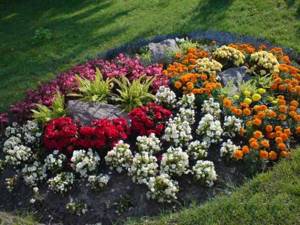
Composition of low-growing flowers
The advantage of perennial low-growing flowers for flower beds is the fact that you don’t have to think about what composition to create next year. You just have to properly care for the plantings.
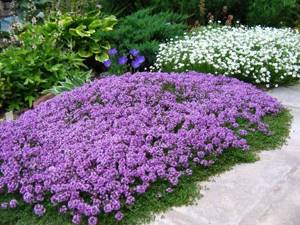
Flowerbed of low-growing perennials
If you are interested in a quick option for creating a beautiful composition, then purchasing annual plants would be an excellent solution. This option will provide the following advantages:
- You can immediately create the perfect composition.
- At the time of planting, the colors of the flowerbed being formed are visible.
- Initially, the correct pattern is formed, the desired ornament is created.
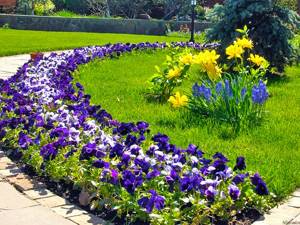
Colorful border of annuals
If you want to create a beautiful carpet of living plants, then the best option is to use small flowers. You can choose the type of plants you want to create a stunning cover that will evenly cover open areas.
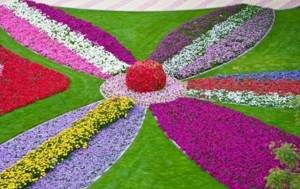
Bright carpet of annual flowers
Another positive point is the fact that such plants do not require complex care, the addition of feeding elements and frequent watering. Accordingly, some types of plants are used for an area located on the sunny side, and others for the shady side.
Spring plants
Early crops will help create bright islands on the site after the snow melts. Beautiful flowers appear from the ground on the first warm days. Properly selected spring low-growing perennials will illuminate flower beds and borders with spectacular blooms.
Crocuses
Narrow basal leaves grow from the bulb, which are collected in a small bunch. The height of the plant varies between 7-15 cm. Single goblet-shaped buds reach 5 cm in diameter. Depending on the variety, flowering occurs:
- white;
- creamy;
- blue;
- lilac;
- yellow.
Bordered, two-tone or spotted patterns are common. Petals with scales open on a short peduncle. Flowering duration is 2-3 weeks. Low-growing perennials can withstand frosts down to -8 C and look spectacular in the snow. When the temperature rises to +20 C, crocuses fade within a day.
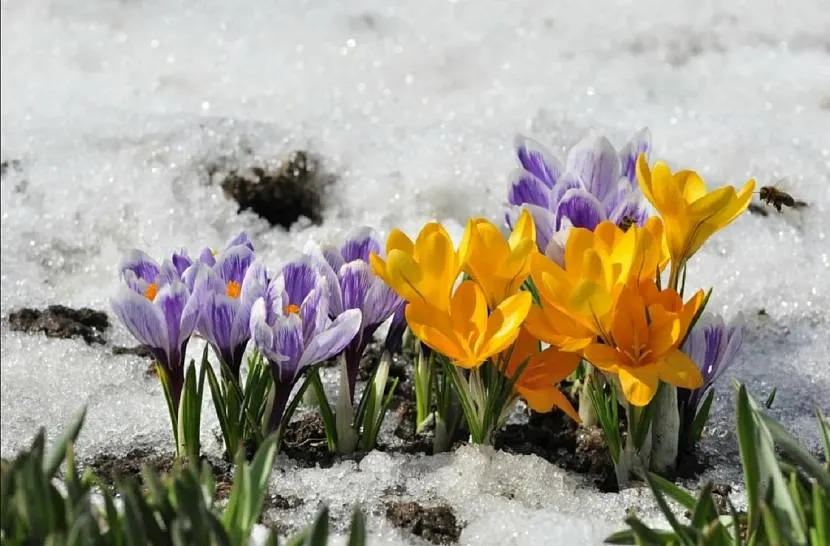
Low perennial primroses Source yandex.ua
Bulbous plants are planted in August-September. Primroses prefer to develop in well-lit areas or in the partial shade of unblown bushes. Due to the variety of shapes and shades, crocuses look beautiful both solo and in combination with other species. The culture is often used for group plantings in flower beds or among rock garden stones. Every 4 years, primroses are planted, otherwise the decorative effect of the buds is lost.
Hyacinths
Representatives of the species can be recognized by their voluminous peduncle covered with many small flowers of white, blue or burgundy hue. Thin long leaves are collected in a loose bunch. Like crocuses, at temperatures above +20 C, hyacinths quickly fade. The height of the low-growing perennial does not exceed 20 cm.
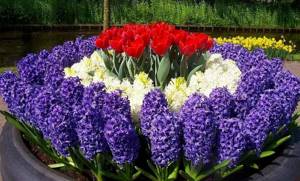
Beautiful first perennials Source flo.discus-club.ru
Plants grow well in light partial shade of deciduous bushes and trees. Primroses prefer fertile soil with a neutral pH. The culture does not like waterlogging, so it is better to plant it at higher elevations. The buds begin to be thrown out from the second year of life.
Daffodils
Low-growing varieties of spring bulbous species look very decorative and graceful. The Tazetta hybrid has up to 5 creamy-yellow buds with a diameter of 2.5 cm on one peduncle. The height of the plant does not exceed 15 cm. The opening period of the petals lasts from the end of March to April.
Daffodils from the group of Jonquillies and Tubulars look original. The rich green perianth emphasizes the brightness of the golden crown. The culture grows no more than 20 cm. On one peduncle, 3-4 buds develop, collected in a loose bouquet. Varieties open their petals in mid-late spring, pleasing for 3 weeks.
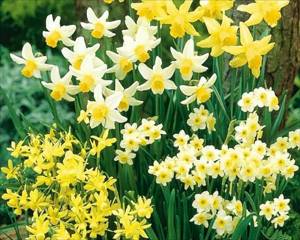
Graceful low-growing perennials Source agricultural portal.rf
Tulips
Dwarf botanical species are low-growing perennials, the height of which does not exceed 30 cm. In tiny, graceful crops, the bud size is 5 cm. Miniature tulips harmoniously combine the features of a wild plant and a cultivated hybrid:
- resistant to “onion” fungi;
- no need to dig up for the winter;
- do not require a garter.
Unlike crocuses and traditional tulips, the low-growing plant grows well in partial shade. The intensity of the sun does not affect the appearance of buds and the brightness of the petals. The culture blooms in late March-early April when the weather is warm.
Periwinkles
The evergreen perennial will delight you with its beauty in the spring throughout the growing season. After the soil warms up, the surface is covered with multiple buds. The diameter of the petals does not exceed 3 cm. Shades vary from soft blue to rich burgundy.
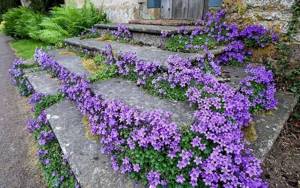
Design with periwinkle Source podkarpackiesady.pl
The flowering period for periwinkles is from May to early June. In summer, the low-growing perennial is used as a ground cover. Figured greens can be either elegant glossy or brightly spotted. The culture is characterized by slow development and love of shade, so it is planted under bushes or young (dwarf) trees.
The most beautiful
Low-growing perennials with decorative buds will become a bright continuation of landscape design. Thanks to their compactness, the plants will not take up much space, but at the same time they look impressive and unusual. Among the beautiful crops, designers distinguish 5 types.
Lupine
Low-growing and dwarf perennials from the legume family do not grow above 50 cm. The dense shrub consists of bluish curly foliage. Small fleshy buds are collected in a loose spikelet on a peduncle. Depending on the variety, the shades of the petals vary from delicate white and blue to rich red, yellow and purple.
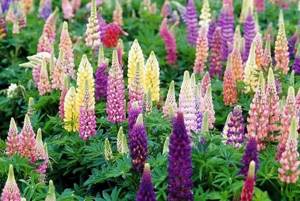
Low-growing perennial Source etsy.com
Flowering begins at the end of May and lasts until mid-summer. Perennial lupine looks spectacular along paths, on an alpine hill or in a ridge. Large foliage masks garden communications. The short, handsome plant develops on slightly acidic soils; excess alkali will provoke disease. Abundant and lush release of buds is the result of regular potassium-phosphorus fertilizing. Nitrogen fertilizers lead to rotting of the roots.
Aquilegia
This beautiful herbaceous perennial, if properly cared for, will live for 5 years, after which it must be transplanted to another location. Low-growing species range in height from 15 to 40 cm. The diameter of graceful flowers is from 4 to 8 cm. The shades of the petals vary from soft cream to rich:
- blue;
- beet;
- red.
Aquilegia grows well in sandy and loose soil. Due to its powerful roots, the catchment is resistant to drought, but loves abundant watering and regular fertilizing. To prevent perennials from freezing, they are insulated for the winter. The culture looks impressive both solo and in company with decorative foliage species.
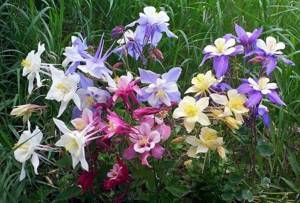
Compact catchment varieties Source my-farmer.ru
Astilbe
Dwarf varieties do not grow higher than 30 cm. A compact bush with an arched panicle inflorescence will become a bright spot in the garden. The plant looks harmonious in a park or along a small pond. The culture prefers to develop under the shade of trees, bushes or more massive species.
Rules for caring for low-growing flowers for flower beds
If you want to enjoy the lush flowering of plants, then you need to not only choose the option you like, but also carefully read the conditions for planting and caring for flowers.
Before you go looking for seedlings, you need to:
- Carefully study the layout of your yard. You need to correctly determine which side is sunny and which is shady.
- You should select separate types of flowers for a sunny area, and separately for a shady area.
- Consider options for creating a design, you can consult with specialists.
- Before you start planting, you need to familiarize yourself with the planting rules, the need for fertilizer and soil moisture.
Next, you need to carefully familiarize yourself with the method of watering certain types of flowers. It is unacceptable to overdry or overly moisten the soil; you must maintain optimal conditions.
Initially, it is recommended to contact an experienced gardener who can visit your site and give the necessary recommendations. This way you can ensure lush flowering and stylishly decorate your yard.
Modern courtyards, as a rule, have a large area. You can create a unique design, divide the territory into several zones intended for recreation. Low-growing flowers for flower beds will decorate borders and paths, form slides and multi-tiered compositions. Ornaments made from plants look great.
Decorative deciduous crops
Not all low-growing plants offer spectacular buds. The inconspicuousness of flowering is compensated by the original shape or shades of foliage. Perennials from the decorative deciduous group can decorate a flower bed, border or garden composition.
Spurge
Low-growing representatives of the Euphorbiaceae family are valued for their ease of care and spectacular appearance. Thanks to selection, there are more than 150 plant hybrids that are radically different from each other. Perennials look harmonious both in compositions and solo.
Cypress spurge reaches a height of 45 cm. The variety resembles non-thorny coniferous branches. The unpretentious crop does not freeze at -20 C, which makes it possible to grow in cold regions. The low-growing perennial is planted in the root circles of trees, in alpine slides or as an addition to multi-flowered compositions.
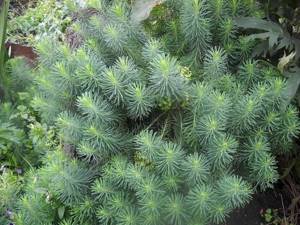
Compact Christmas trees Source osennyayalyubov.www.nn.ru
The height of the miniature myrtle-leaved milkweed is 20 cm. The fleshy plates are collected in a rigid spiral-shaped rosette, so the plant resembles a young succulent (stone rose). Red or green shades appear on the bluish foliage. The regrown stems spread beautifully along the ground, covering defects in the landscape.
Heuchera
Among the low-growing perennials, gardeners distinguish representatives of the Saxifraga family. Herbaceous compact shrub does not grow more than 40 cm in height. Basal leaves on petioles consist of several parts. The flowering is inconspicuous in the form of a small panicle on a thin stem.
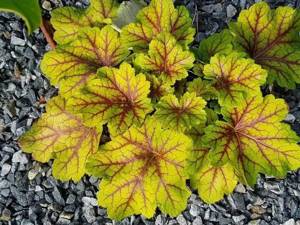
Bright perennial Source domashniecvety.ru
The American heuchera variety has beautiful curly leaves that are collected in a compact rosette. Green plates are streaked with red veins, so the culture looks bright and unusual. During the season it changes color several times, which allows you to update the landscape design.
Heuchera pilosa is easily recognized by its decorative foliage with velvet edges. The plant prefers to grow in the shade in moist, nutritious soil. The culture is used in solo compositions or in the root circle of large trees.
Khosta
Another large family of perennials, among which there are low-growing species. An unpretentious shrub with spectacular decorative leaves is not afraid of frost and drought. A gardener can adjust the intensity of color or the size of the greenery by planting the plant in shade or sun.
Hostas are stemless crops, the greenery of which is collected in a free rosette. The plates rise above the ground, hiding irrigation pipes or soil defects from prying eyes. Low-growing perennials are divided into 5 groups according to height:
- Dwarf. Tiny species do not grow higher than 10 cm. The light blue foliage is shaped like mouse ears.
- Mini. The size of the bushes is up to 15 cm. You can recognize it by its spotted tricolor plates.
- Small ones. Plants within 20-25 cm are characterized by a bright border along the edge of the greenery.
- Average. Hostas grow up to 45 cm. The foliage is emerald with a light center.
- Big ones. The crops reach 55-65 cm in height. The blades are very decorative, often with colored veins, borders or compression.
Low-growing perennials can be grown in one place for 20 years. Maximum beauty is revealed 5 years after planting. The plant likes to grow in nutritious, well-drained soil. The crop needs only periodic loosening of the soil, removal of weeds and application of complex fertilizer. Young specimens require frequent watering to develop; adults can withstand slight drought.
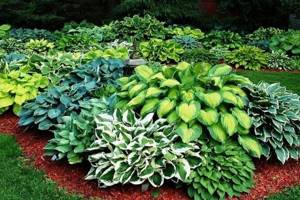
Decorative deciduous species Source marusin-sad.com
Blue fescue
The low-growing grass barely reaches 55 cm in height. The perennial grows in the form of a spherical hummock, which looks impressive in alpine hills, along borders and in mixed flower beds. The ornamental grass has long narrow leaves, painted in shades of blue - from gray and silver to rich blue. The crop blooms with inconspicuous spikelets, which gardeners recommend cutting off.
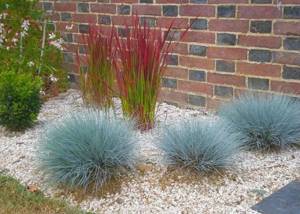
Ornamental cereals in the garden Source sovintech.ru
To prevent fescue from degenerating, a rejuvenating transplant is needed every 4 years. The procedure will preserve the decorative appearance of the plant and improve frost resistance. This beautiful sun-loving grass is pruned twice a year, removing old dead leaves. The culture is more afraid of flooding than drought.
Variegated warbler
The low-growing perennial groundcover was obtained by domesticating weeds. The plant has inconspicuous flowers, but spectacular spotted leaves. Young plates are painted soft green, with a chaotic border along the edge. As the foliage matures, it acquires a noble pistachio color, complemented by a white border.
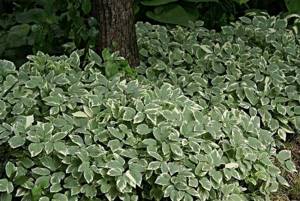
Handsome, moisture-loving Source dachnaya-zhizn.ru
Variegated gooseberry is undemanding to soil quality and care conditions. The muted palette of the records shows up better in the shadows. In landscape design, crops are planted in the root circles of trees, forming a decorative carpet. The ground cover will complement the composition with moisture-loving bushes. Representatives of the species will decorate the foreground of mixborders and alpine slides.
Annual low-growing flowers for flower beds
If you are a fan of constantly changing the design of the territory, then it makes sense to opt for annual plants. There are many types of flowers that allow you to create beautiful compositions.
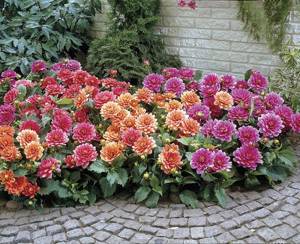
Annuals make it easy to change the design of flower beds
One of the popular species is purslane, which can grow in arid soils. Terry petals look incredibly beautiful and serve as an elegant decoration for slopes, stone walls or borders. Flowers are easy to care for and thrive in sunny places.
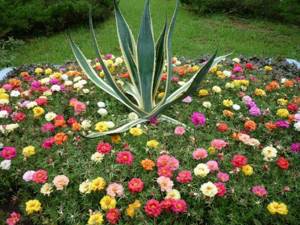
Flowerbed of terry purslanes
If your site is located in a damp area, then planting calceolaria would be an excellent solution. Such plants begin to bloom in early March, and their beautiful appearance lasts until June. However, care should be taken to ensure that the soil is well moistened; special fertilizers are needed.
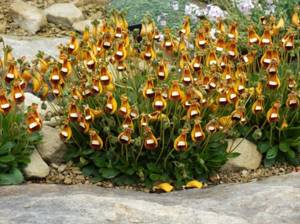
Calceolaria is an excellent option for low-growing flower beds
Do you want to get reliable decoration of your site for a long time? An excellent choice would be ageratum, which can bloom throughout the summer, as well as in the fall. Great for decorating lawns and borders. You will need to regularly water the plant and apply certain fertilizers. When caring, it is recommended to remove parts of the stem that have begun to dry out.
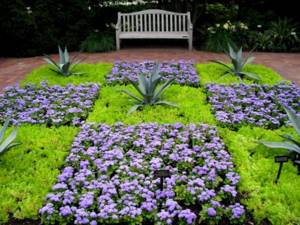
A flowerbed made of ageratum will delight you with flowering throughout the summer.
Want to create a colorful rug made from small plants? A wonderful option would be to plant marigolds, which have many colors. You can choose the desired shades and create original compositions. These plants are quite unpretentious and do not require frequent watering. With the help of marigolds, you can equip a lawn or lawn.
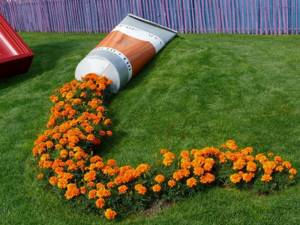
Original flowerbed of marigolds
Do you want to create a lush carpet made up of flowers?
Unpretentious gatsaniya will be one of the simplest options. All care comes down to regular watering and periodic application of fertilizers. The flowering of the plant lasts until the end of the autumn period. You will receive bright inflorescences that serve as a harmonious decoration of the site.
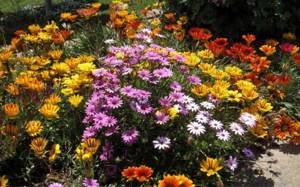
Lush carpet made of gatsaniya
Are you interested in a particularly striking solution? A wonderful option would be to plant daisies. They can be used to independently form a flower bed, resulting in an attractive and bright composition. It is possible to combine planting with bulbous plants; they create a luxurious edging. Daisies are quite easy to care for.
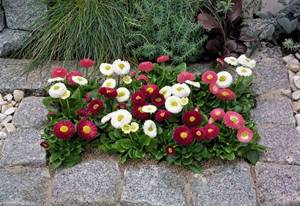
Flowerbed of unpretentious daisies
